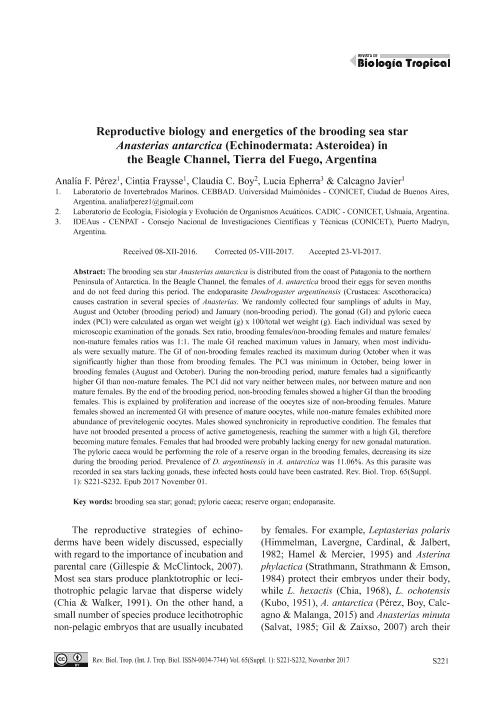Artículo
Reproductive biology and energetics of the brooding sea star anasterias antarctica (Echinodermata: Asteroidea) in the beagle channel, Tierra del Fuego, Argentina
Pérez, Analía Fernanda ; Fraysse, Cintia Pamela
; Fraysse, Cintia Pamela ; Boy, Claudia Clementina
; Boy, Claudia Clementina ; Epherra, Lucía
; Epherra, Lucía ; Calcagno, Javier Ángel
; Calcagno, Javier Ángel
 ; Fraysse, Cintia Pamela
; Fraysse, Cintia Pamela ; Boy, Claudia Clementina
; Boy, Claudia Clementina ; Epherra, Lucía
; Epherra, Lucía ; Calcagno, Javier Ángel
; Calcagno, Javier Ángel
Fecha de publicación:
06/2017
Editorial:
Universidad de Costa Rica
Revista:
Revista de Biología Tropical
ISSN:
0034-7744
Idioma:
Inglés
Tipo de recurso:
Artículo publicado
Clasificación temática:
Resumen
The brooding sea star Anasterias antarctica is distributed from the coast of Patagonia to the northern Peninsula of Antarctica. In the Beagle Channel, the females of A. antarctica brood their eggs for seven months and do not feed during this period. The endoparasite Dendrogaster argentinensis (Crustacea: Ascothoracica) causes castration in several species of Anasterias. We randomly collected four samplings of adults in May, August and October (brooding period) and January (non-brooding period). The gonad (GI) and pyloric caeca index (PCI) were calculated as organ wet weight (g) x 100/total wet weight (g). Each individual was sexed by microscopic examination of the gonads. Sex ratio, brooding females/non-brooding females and mature females/ non-mature females ratios was 1:1. The male GI reached maximum values in January, when most individuals were sexually mature. The GI of non-brooding females reached its maximum during October when it was significantly higher than those from brooding females. The PCI was minimum in October, being lower in brooding females (August and October). During the non-brooding period, mature females had a significantly higher GI than non-mature females. The PCI did not vary neither between males, nor between mature and non mature females. By the end of the brooding period, non-brooding females showed a higher GI than the brooding females. This is explained by proliferation and increase of the oocytes size of non-brooding females. Mature females showed an incremented GI with presence of mature oocytes, while non-mature females exhibited more abundance of previtelogenic oocytes. Males showed synchronicity in reproductive condition. The females that have not brooded presented a process of active gametogenesis, reaching the summer with a high GI, therefore becoming mature females. Females that had brooded were probably lacking energy for new gonadal maturation. The pyloric caeca would be performing the role of a reserve organ in the brooding females, decreasing its size during the brooding period. Prevalence of D. argentinensis in A. antarctica was 11.06%. As this parasite was recorded in sea stars lacking gonads, these infected hosts could have been castrated.
Palabras clave:
Brooding Sea Star
,
Endoparasite
,
Gonad
,
Pyloric Caeca
,
Reserve Organ
Archivos asociados
Licencia
Identificadores
Colecciones
Articulos(SEDE CENTRAL)
Articulos de SEDE CENTRAL
Articulos de SEDE CENTRAL
Citación
Pérez, Analía Fernanda; Fraysse, Cintia Pamela; Boy, Claudia Clementina; Epherra, Lucía; Calcagno, Javier Ángel; Reproductive biology and energetics of the brooding sea star anasterias antarctica (Echinodermata: Asteroidea) in the beagle channel, Tierra del Fuego, Argentina; Universidad de Costa Rica; Revista de Biología Tropical; 65; 1; 6-2017; S221-S232
Compartir
Altmétricas



